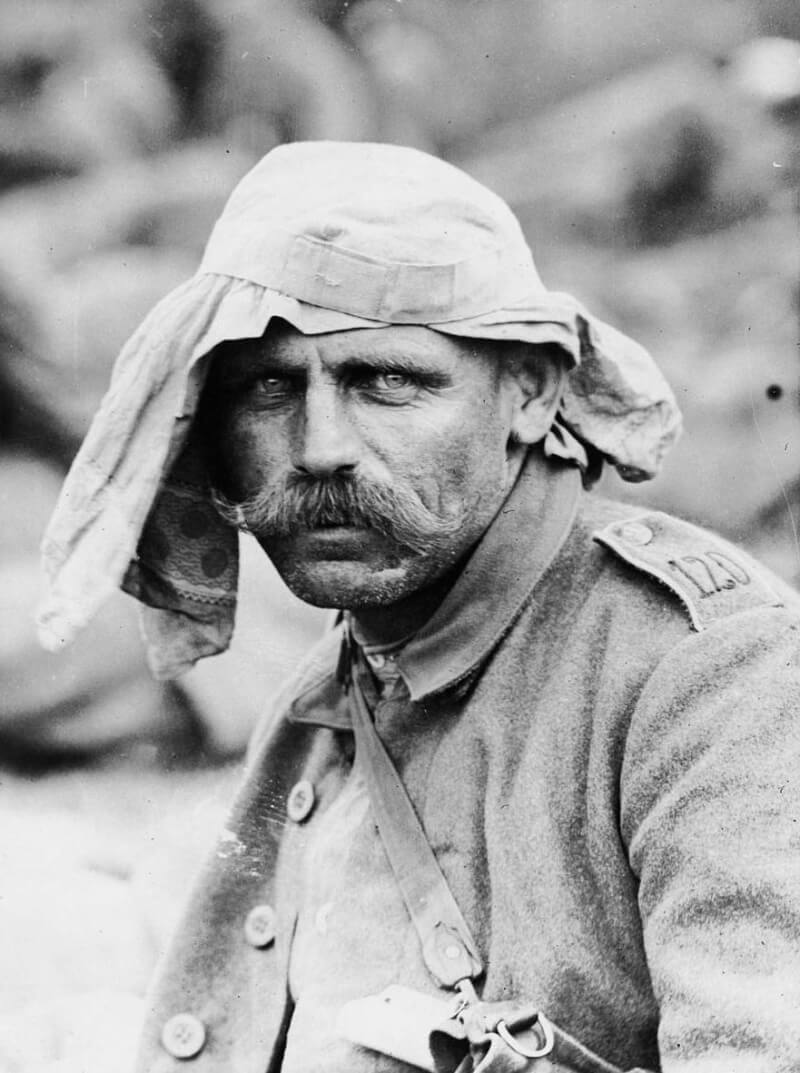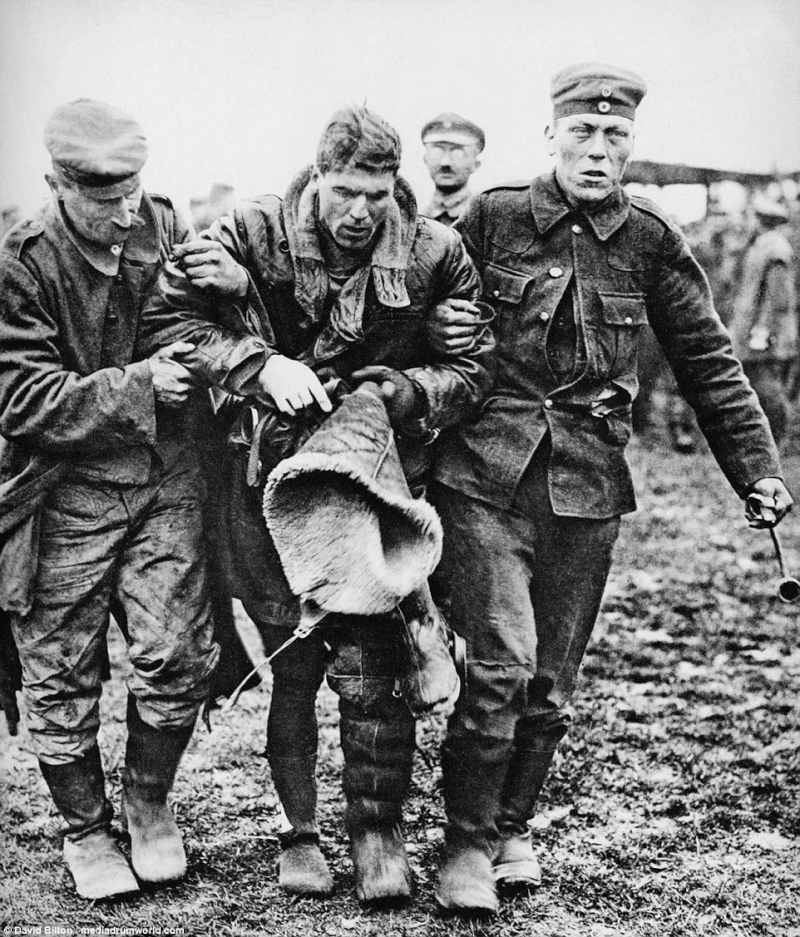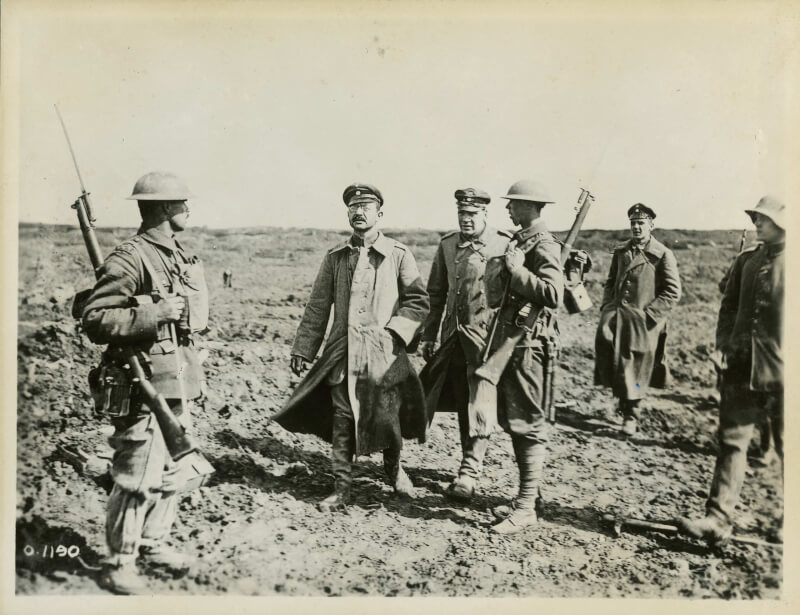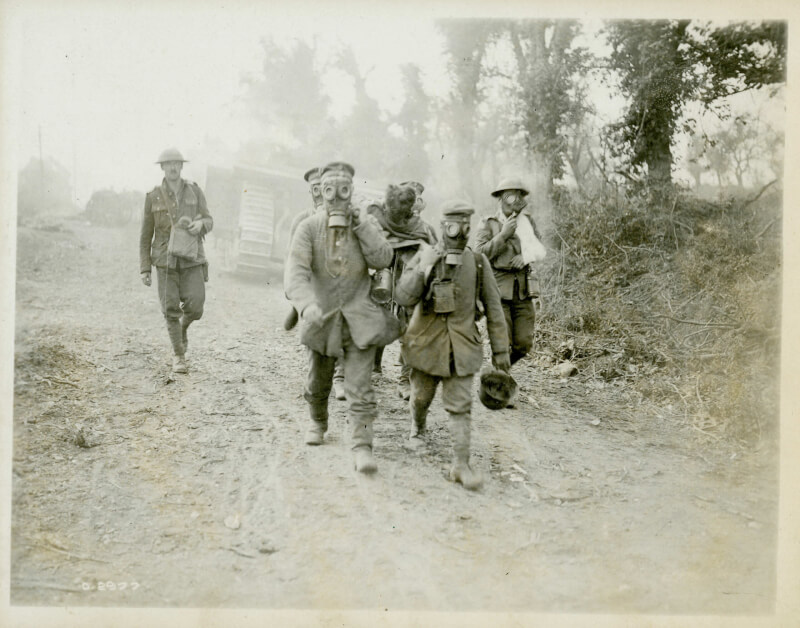
A portrait of a German prisoner of war taken during the First World War. All sides sometimes shot surrendering enemy in the field.
[ National Library of Scotland/Wikimedia]
“This foul act of treachery was observed by the men of his Company, with the result that none of the occupants of the trench were allowed to escape alive,” reported Brigadier-General Robert Rennie, commander of the 4th Brigade.
Later, as the third wave mopped up enemy positions, Lance Cottermole of the 21st Battalion (Eastern Ontario) watched as a young German, “scruffy, bareheaded, cropped hair, and wearing steel-rimmed spectacles, ran, screaming with fear, dodging in and out amongst us to avoid being shot, crying out ‘Nein! Nein!’
“He pulled out from his breast pocket a handful of photographs and tried to show them to us (I suppose they were of his wife and children) in an effort to gain our sympathy. It was all of no avail. As the bullets smacked into him he fell to the ground motionless, the pathetic little photographs fluttering down to the earth around him.”
The Hague Conventions of 1899 and 1907 established the rights of captive combatants and declared the mistreatment and execution of prisoners of war illegal. But the realities of life, and death, for everyone on the battlefield have never been as cut and dried as one might want to believe.
Courcelette wasn’t the first time either side had killed surrendering troops. And Tim Cook, author of 13 books on Canada’s military history, says there’s “ample evidence” to disprove the old belief that such injustices were the sole domain of the enemy.
In his 2006 paper The Politics of Surrender: Canadian Soldiers and the Killing of Prisoners in the Great War, Cook wrote that Canadian infantrymen and other dominion troops, along with British, Germans and “likely all soldiers, regularly executed prisoners on the battlefield.”
“Cutting across almost all units in the Canadian Expeditionary Force (CEF) and reported from the lowest private to the highest-ranking officers, there is no doubt that prisoners of war were killed on the Western Front after surrender,” he said.
“All of these experiences go back to the harsh world of mad, scrambling battles, swirling confusion, with the overpowering smell of freshly spilt blood, soldiers deafened from explosions, hearts pounding with adrenaline and fear.”

German troops lead a wounded Allied pilot to processing as a prisoner of war.
[Unknown]
Both sides employed ruses and harsh retribution for past wrongs, real or perceived.
“Becoming a prisoner was one of the most dangerous acts on the battlefield of the Great War,” wrote Cook. “The pleading of mercy and the downing of weapons did not always stop the bloodshed.
“The moment of capitulation for a potential prisoner was of crucial importance: would the surrender be accepted or would it result in a bayonet thrust?”
In his 2012 paper A Forgotten Victory: Courcelette, 15 September 1916, historian David Campbell said Canadians who killed surrendering enemy were often driven by multiple motives, including revenge, fears of treachery and possible official encouragement.
“Many men in 2nd Canadian Division saw the attack [on Courcelette] as a chance to settle old scores with ‘Fritz’ for the punishments inflicted upon them at St. Eloi, Hooge, and in other smaller deadly encounters,” wrote Campbell.
When one member of the 28th Battalion (Northwest) was questioned about the scarcity of prisoners taken by his unit, he spat back: “We’re not taking any. They blew mines under us twice.”
Brigadier-General Huntly D.B. Ketchen, commander of the 6th Canadian Infantry Brigade, told of an officer of the 3rd Canadian Division who was watching the advance from his position on the left. The observer had described the battalions’ bayonet work as “really magnificent.”
“No wonder,” wrote Ketchen. “These men had been cooped up in the Ypres Salient for many months and were getting a little of their own back.”
Others in the 4th Brigade were equally uncharitable.
“On our advancing,” admitted Lieutenant-Colonel Elmer W. Jones, who was killed in August 1918, “some of the enemy offered to surrender but in most cases these men were bayonetted by our advancing troops.”
“The men were not looking for prisoners, and considered a dead German was the best,” wrote Major-General Richard Turner in his diary.

Canadian troops take German officers prisoner on the battlefield at Vimy Ridge. The Canadians captured more than 4,000 enemy during the fighting in April 1917.
[CWM/19920085-943]
Cottermole claimed that he and his comrades were given strict instructions to take no prisoners until the Canadian objectives had been achieved.
“The reason for this,” explained Cottermole, “was that so often in British advances, when the Germans had thrown down their arms in surrender and our men had moved through them, at the same time indicating to them to go to our rear where they would be collected as prisoners, the Germans had picked up their rifles again and shot our men in the back, thereby bringing the advance to a halt.
“No such risks could or would be taken in this important attack, and orders were reluctantly carried out.”
Campbell noted that no evidence of an official take-no-prisoners directive has ever emerged. “But the exhortation in the divisional operation orders on 14 September to push the attack ‘with the utmost vigour until the objective is reached,’ may have provided some subordinate commanders with justification for encouraging, or even ordering, their men to act ruthlessly.”
PoW executions may have been even more common in the Second World War and have not disappeared in subsequent conflicts.
As many as 156 captured Canadian soldiers were executed by the 12th SS Panzer Division (Hitler Youth) in the days and weeks following the D-Day landings.
The man believed to have ordered the killings, SS-Brigadeführer Kurt Meyer, was linked to massacres on both fronts of the war. He was the only Nazi tried by a Canadian war-crimes tribunal after the Third Reich was defeated.
Meyer was convicted and condemned to death for the most notorious murders, at Abbaye d’Ardenne, a monastery near Caen that served as his headquarters. His sentence was commuted to life by Canadian Major-General Christopher Vokes.
Meyer served five years at Dorchester Penitentiary in New Brunswick and three more at a British military prison in Germany before he was released in 1954. He joined a Waffen-SS lobby group on his release and was considered a leading apologist for the combat arm of Hitler’s most fanatical loyalists.

German PoWs in gas masks are led away.
[CWM]
“Both German and Japanese forces continued to fight tenaciously long after any realistic chance of victory had disappeared,” he noted in 2004. “Part of the explanation lies in the extremely violent battlefield culture that developed…which deterred soldiers from surrendering, even when they found themselves in hopeless situations.
“This culture had its origins on the Western Front during the First World War,” he added. “But in the Second World War it became official policy on both sides, not only on the Eastern Front but in the Pacific theatre, as well.
“Only when the Allied authorities adopted techniques of psychological warfare designed to encourage rather than discourage surrender did German and Japanese resistance end.”
During the Korean War, as many as 15,000 Allied PoWs—all but 2,000 of them South Koreans—are believed to have died from torture, execution, starvation and medical mistreatment by their captors. They are listed as missing in action.
The torture and killing of Viet Cong and North Vietnamese PoWs, even civilians, by American troops in the field was well-documented during the Vietnam War. Afghanistan was notorious for its poor treatment of PoWs by both Taliban, who tortured and killed coalition captives in the field, and coalition forces, specifically the Americans, who tortured prisoners in-theatre, at the Guantanamo Bay detention facility, and at so-called “black sites,” Central Intelligence Agency-operated secret prisons in Poland and Romania.
Taliban and al-Qaida were technically not soldiers; they wore no uniforms and were considered detainees; therefore, the Americans argued, they bore none of the protections afforded prisoners of war. Captives, including Canadian child-soldier Omar Khadr, were held by the Americans for years without charge.
Both Ukrainian and Russian soldiers are believed to have killed PoWs since Russian President Vladimir Putin ordered his forces to invade Ukraine in February 2022.
Cook suggests the killing of prisoners of war has always been an exercise in futility.
“Prisoners were valuable during the Great War,” he contends. “Not only was the granting of mercy a sign of civilized warfare, but prisoners provided much-needed intelligence, were a source of labour behind the lines, and were tangible proof of battlefield success.
“It did not make sense to murder prisoners. To kill prisoners lessened one’s reputation (by having fewer prisoners to tabulate) and, ultimately, lengthened the war. As long as soldiers thought they might face summary execution after surrender, they would fight to the bitter end.
“Killing prisoners did not help to win wars.”
Advertisement


















